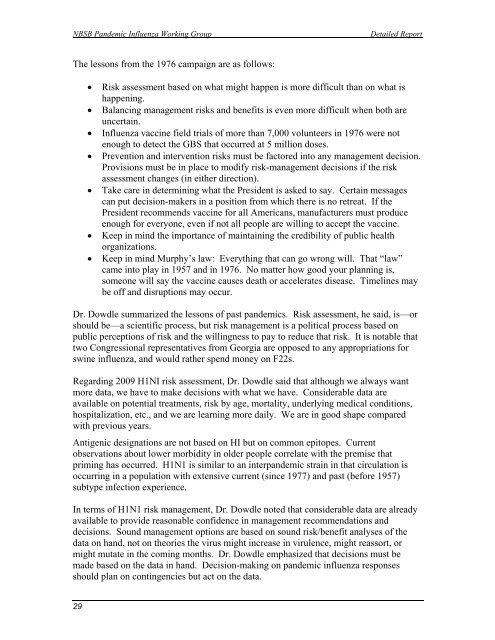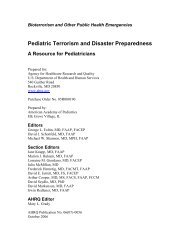H1N1 COUNTERMEASURES STRATEGY AND ... - PHE Home
H1N1 COUNTERMEASURES STRATEGY AND ... - PHE Home
H1N1 COUNTERMEASURES STRATEGY AND ... - PHE Home
Create successful ePaper yourself
Turn your PDF publications into a flip-book with our unique Google optimized e-Paper software.
NBSB Pandemic Influenza Working Group<br />
Detailed Report<br />
The lessons from the 1976 campaign are as follows:<br />
<br />
<br />
<br />
<br />
<br />
<br />
<br />
Risk assessment based on what might happen is more difficult than on what is<br />
happening.<br />
Balancing management risks and benefits is even more difficult when both are<br />
uncertain.<br />
Influenza vaccine field trials of more than 7,000 volunteers in 1976 were not<br />
enough to detect the GBS that occurred at 5 million doses.<br />
Prevention and intervention risks must be factored into any management decision.<br />
Provisions must be in place to modify risk-management decisions if the risk<br />
assessment changes (in either direction).<br />
Take care in determining what the President is asked to say. Certain messages<br />
can put decision-makers in a position from which there is no retreat. If the<br />
President recommends vaccine for all Americans, manufacturers must produce<br />
enough for everyone, even if not all people are willing to accept the vaccine.<br />
Keep in mind the importance of maintaining the credibility of public health<br />
organizations.<br />
Keep in mind Murphy’s law: Everything that can go wrong will. That “law”<br />
came into play in 1957 and in 1976. No matter how good your planning is,<br />
someone will say the vaccine causes death or accelerates disease. Timelines may<br />
be off and disruptions may occur.<br />
Dr. Dowdle summarized the lessons of past pandemics. Risk assessment, he said, is—or<br />
should be—a scientific process, but risk management is a political process based on<br />
public perceptions of risk and the willingness to pay to reduce that risk. It is notable that<br />
two Congressional representatives from Georgia are opposed to any appropriations for<br />
swine influenza, and would rather spend money on F22s.<br />
Regarding 2009 H1NI risk assessment, Dr. Dowdle said that although we always want<br />
more data, we have to make decisions with what we have. Considerable data are<br />
available on potential treatments, risk by age, mortality, underlying medical conditions,<br />
hospitalization, etc., and we are learning more daily. We are in good shape compared<br />
with previous years.<br />
Antigenic designations are not based on HI but on common epitopes. Current<br />
observations about lower morbidity in older people correlate with the premise that<br />
priming has occurred. <strong>H1N1</strong> is similar to an interpandemic strain in that circulation is<br />
occurring in a population with extensive current (since 1977) and past (before 1957)<br />
subtype infection experience.<br />
In terms of <strong>H1N1</strong> risk management, Dr. Dowdle noted that considerable data are already<br />
available to provide reasonable confidence in management recommendations and<br />
decisions. Sound management options are based on sound risk/benefit analyses of the<br />
data on hand, not on theories the virus might increase in virulence, might reassort, or<br />
might mutate in the coming months. Dr. Dowdle emphasized that decisions must be<br />
made based on the data in hand. Decision-making on pandemic influenza responses<br />
should plan on contingencies but act on the data.<br />
29
















